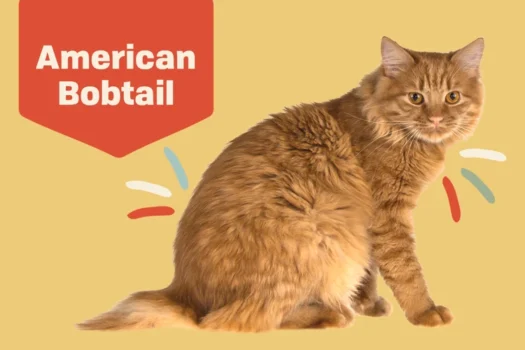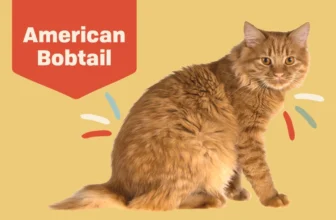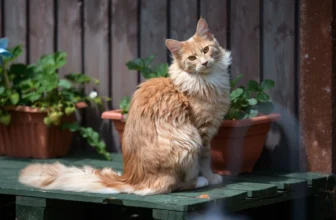As cat owners, we love to understand our feline friends at a deeper level. One breed in particular, the American Bobtail, has unique body language cues that can tell us a lot about their thoughts and feelings. By observing their tail, ear, and body posture, as well as facial expressions and vocalizations, we can gain a better understanding of what our American Bobtails are trying to communicate to us. In this article, we’ll delve into the fascinating world of American Bobtail body language, interpreting specific behaviors, and communicating with them in a way that strengthens our bond and increases their trust in us.
Basics of American Bobtail Body Language
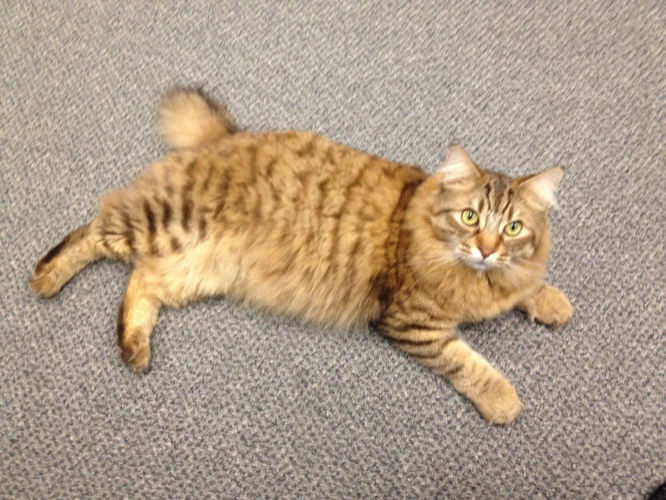
The way our feline friends communicate is fascinating, and understanding their body language is crucial for building a strong bond with them. American Bobtails, in particular, have a unique way of expressing themselves that can clue you in to their mood and intentions. Learning the basics of American Bobtail body language is an excellent place to start your journey towards better understanding your furry companion. By observing their tail position, ear position, eye contact and facial expressions, vocalizations, and body posture, you can start interpreting their specific behaviors. In the following sections, we’ll guide you through the various aspects of American Bobtail body language and provide insights into what they mean.
Tail Position
One of the most important ways to understand your American Bobtail’s body language is by observing their tail position. American Bobtails have a unique tail that can be straight, curved, kinked or bobbed. Each type of tail position conveys a different meaning.
- A straight tail held high is a sign of confidence and contentment.
- When the tail is held low and straight, it may indicate fear or submission.
- A twitching tail can be a sign of excitement, playfulness, or anticipation, especially when the tail is raised.
- When the tail is puffed up and bristled, it indicates that your American Bobtail is feeling threatened, scared, or angry.
- An upright tail with a hooked tip expresses a curious or alert American Bobtail.
It is important to understand tail position in conjunction with other behaviors to accurately interpret your American Bobtail’s actions. For example, a puffed-up tail combined with hissing may indicate aggression or fear.
If you observe your American Bobtail showing any signs of fear or aggression, it is crucial to take steps towards socialization and training to prevent unwanted behavior. However, if your American Bobtail is expressing contentment and happiness through a high, straight tail, you may want to bond with your pet through play or affection. Additionally, by recognizing aggressive behavior, you can better prevent unwanted conflicts with other pets or children in your household, as well as protect your American Bobtail from harm.
To better understand the unique body language traits of American Bobtails, it is important to also consider other factors such as genetics and personality. By doing so, you can create a safe and nurturing environment that allows for trust, healthy communication, and a stronger bond with your feline friend.
Ear Position
One of the most significant and noticeable ways to understand your American Bobtail’s body language is by observing their ear position. The position of their ears can tell you a lot about what they are feeling and thinking. Here are some ear positions that you may observe in American Bobtails and what they might indicate:
- Up and Alert: When your American Bobtail’s ears are up straight and alert, they are likely feeling curious or interested in something around them. This is a sign of a attentive and inquisitive Bobtail.
- Slightly Back: If your American Bobtail slightly pulls back their ears, it could indicate that they are feeling uneasy or unsure.
- Flat Against Head: When your American Bobtail’s ears are flat against their head, it can mean that they are experiencing fear or aggression.
- Slightly Forward: If the ears of your American Bobtail are slightly forward, it can indicate they are in a playful mood or are excited about something.
To truly understand your American Bobtail’s ear position, you need to observe their body language as a whole rather than relying solely on ear position. For example, if your Bobtail has flat ears against their head along with a puffed-up tail, it may signify that they are feeling aggressive or fearful.
It’s important to understand your American Bobtail’s ear position because it can help you avoid unwanted situations. For instance, if their ears are flat against their head, you may want to avoid taking them to crowded places or around other pets. If their ears are up and alert, take the opportunity to introduce them to new things and people.
Understanding the ear positions of American Bobtails can help you maintain a strong bond with your furry friend. If you want to learn more about American Bobtail body language, check out our article on recognizing aggressive behavior in American Bobtails.
Eye Contact and Facial Expressions
One of the most subtle yet significant ways that American Bobtails communicate through body language is through eye contact and facial expressions. Just like humans, eye contact can express a variety of emotions and intentions, and it’s important for owners to understand what their felines are trying to convey.
Eye Contact: When a Bobtail makes direct eye contact with their owner, it’s a sign of trust and affection. They are essentially telling their owner that they feel safe and comfortable around them. If a Bobtail is feeling anxious or afraid, they may avoid eye contact altogether or dart their eyes around nervously.
Blinking: Another form of eye communication is blinking. Slow blinks are often referred to as “kitty kisses” and are a sign of contentment and relaxation. If your Bobtail gives you prolonged, slow blinks, it’s a sign that they feel comfortable and at ease with you. If they quickly open and close their eyes, it can be a sign of fear or discomfort.
To better understand your American Bobtail’s facial expressions, refer to the table below:
| Facial Expression | Meaning |
|---|---|
| Raised Eyebrows | Surprise or fear |
| Half-Closed Eyes | Contentment, relaxation |
| Dilated Pupils | Excitement, fear, or aggression |
| Flattened Ears | Fear, aggression, or discomfort |
| Widened Eyes and Open Mouth | Fear, surprise, or aggression |
| Relaxed Mouth | Contentment |
| Tensed Mouth | Discomfort, fear, or aggression |
By paying attention to your American Bobtail’s body language, including their eye contact and facial expressions, you can better understand their emotions and needs. This can help to strengthen the bond between you and your furry friend and ensure that they feel safe and comfortable in their environment.
Vocalizations
Cats are generally known for their vocalizations, and American Bobtails are no exception. While they may not vocalize as much as other cats, they do have their fair share of sounds they make. Here are some of the vocalizations commonly observed in American Bobtails:
- Growling: Growling is a low, guttural sound that cats make when they are angry or feel threatened.
- Hissing: Hissing is a more intense version of growling, where cats will expel air through their teeth to make a hissing sound. This is usually a warning sign that the cat is about to attack or feels threatened.
- Chirping: Chirping is a unique vocalization that American Bobtails make when they get excited or see something they want to catch. It’s a combination of a meow and a trill, and is a pretty adorable sound!
- Meowing: American Bobtails don’t meow as much as other cats, but they still do it from time to time. They might meow if they’re hungry, want attention, or if they’re communicating with their owners.
- Purring: Purring is a sound that cats make when they’re feeling content and happy. American Bobtails might purr when they’re getting attention from their owners, or when they’re curled up in a cozy spot.
It’s important to pay attention to your American Bobtail’s vocalizations, as they can help clue you in to how they’re feeling. For example, if your cat starts hissing or growling, it could mean they are feeling scared or angry. On the other hand, if they’re chirping or purring, it’s a sign they’re feeling happy and content. By learning to interpret your American Bobtail’s vocalizations, you can better understand their needs and emotions.
Body Posture
The body posture of an American Bobtail can reveal a lot about their current state of mind and how they’re feeling. Understanding your cat’s body language can help you respond appropriately and better meet their needs. Here are some common body postures you might see and what they might mean:
| Posture | Meaning |
|---|---|
| Arched back | Your cat is feeling threatened or defensive. They may hiss, growl, or lash out if you continue to approach. |
| Hunched or crouched | This is a classic hunting pose. Your cat is getting ready to pounce on something they perceive as prey. |
| Relaxed, stretched out | This is a sign that your cat is comfortable and content. They feel safe and are likely to be receptive to affection and playtime. |
| Stiff, tense | This could mean your cat is on alert, preparing to defend themselves or ready to escape. They may be feeling anxious or stressed. |
| Tucked in, rolled up | A cat who tucks in their legs or curls up tightly is indicating that they feel vulnerable or scared. They may be seeking a hiding place. |
It’s important to interpret body posture in the context of the situation. For example, a cat who is arching their back while playing with a toy isn’t necessarily feeling threatened. Additionally, some cats may have their own unique postures that they use to communicate with you. Take note of your cat’s body language and see if you can identify any patterns or consistent behaviors. This can help deepen your understanding of your cat’s needs and emotions.
Interpreting Specific Behaviors
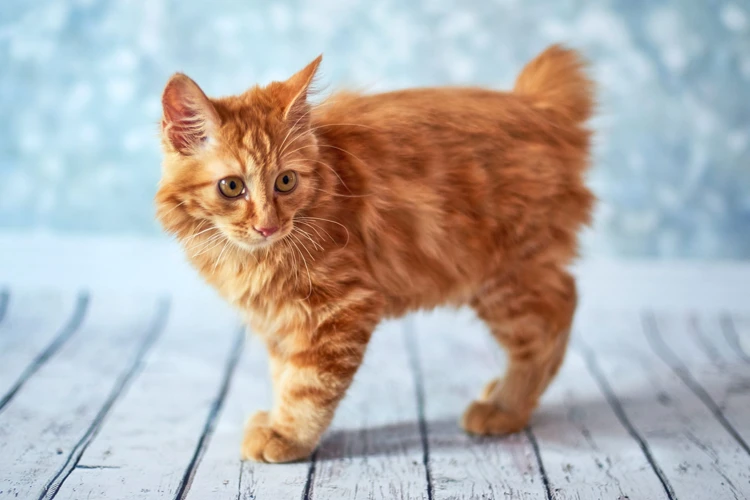
Now that you have a basic understanding of American Bobtail body language, it’s time to dive deeper into interpreting specific behaviors. As an attentive owner, you’ll want to be able to decipher your furry friend’s complex communication system accurately. By paying close attention to their subtle movements, you’ll be able to gain a deeper understanding of their needs, wants, and emotions. In this section, we’ll explore some common Bobtail behaviors and what they might signify. So, let’s get started and unravel the mystery behind your American Bobtail’s body language!
Playfulness
As playful creatures, American Bobtails often communicate their desire to play through various body language cues. These cues are important to understand in order to ensure that your beloved feline is receiving enough stimulation. Here are some specific behaviors to look out for:
- Rolling onto their back: When your American Bobtail rolls onto their back, it is a clear sign that they are in the mood to play. This gesture also indicates that your furry friend is feeling relaxed and comfortable.
- Tail twitching: An American Bobtail’s tail can be a great indicator of playfulness. If you notice that their tail is twitching, it’s a good sign that they want to play with you or with a toy.
- Pouncing: American Bobtails have a natural hunting instinct, which means that they may suddenly pounce on objects or toys in an attempt to “hunt” them. Don’t be alarmed if your Bobtail suddenly lunges at a toy or moves quickly – this is just their playful nature.
- Chasing their tail: Just like dogs, American Bobtails may chase their tails as a form of play. This can be a fun and entertaining behavior to watch, but make sure to keep an eye on them to ensure that they don’t become too dizzy or disoriented.
If your American Bobtail is exhibiting any of these playful behaviors, it’s important to engage with them and provide enough stimulation so that they feel satisfied. Playtime is also a great opportunity to bond with your cat – try incorporating interactive toys or engaging in a game of chase to keep them active and entertained.
Aggression and Fear
American Bobtails can display aggressive behavior for various reasons, and it’s important to understand their body language to identify the triggers and de-escalate the situation. Here are some things to look out for:
- Fluffed Fur: When American Bobtails are threatened or scared, they may puff up their fur to make themselves appear larger. This is a clear sign of fear or aggression.
- Hissing and Growling: Similar to domestic cats, American Bobtails may hiss or growl when feeling threatened or territorial. This is a warning sign that they may attack if the threat persists.
- Direct Eye Contact: In the animal kingdom, direct eye contact can be seen as a sign of aggression. If an American Bobtail is staring you down, take it as a warning sign that they may attack if provoked.
- Back Arched: When threatened or scared, American Bobtails may arch their backs to appear larger and more intimidating. It’s a sign that they are ready to fight or defend themselves.
- Lashing Tail: If an American Bobtail’s tail is lashing back and forth, it can be a sign of agitation and potential aggression.
If you notice any of these signs, it’s best to give your American Bobtail some space to calm down. Don’t try to pet or comfort them, as they may interpret it as a further threat. Instead, try to remove any triggers or threats from the area and give them time to cool off. If the behavior persists or becomes violent, it’s best to seek professional help from a veterinarian or animal behaviorist. Remember, a calm and understanding approach is key to resolving issues with aggression and fear in American Bobtails.
Affection and Contentment
One of the most heartwarming behaviors displayed by American Bobtails is their affection and contentment towards their caretakers. These fuzzy feline friends are known for being loyal pets, and their body language can give us insight into their feelings of joy and happiness.
Purring: When an American Bobtail is affectionate and content, they may begin to purr. Purring is often associated with happiness and relaxation, and it can be a sign that your cat trusts and loves you. You may notice your cat starts to purr when you pet them, hold them, or when they are snuggled up and comfortable.
Slow Blinking: Another sign of contentment in American Bobtails is when they slow blink at you. This is a gesture of trust and affection, and it means your cat feels completely comfortable around you. To reciprocate this gesture, try slowly blinking back at your cat, which can strengthen the bond between you and make them feel even more content.
Showcasing Belly: When a cat is showing its belly, it is not always a sign of trust and affection. However, if your American Bobtail is lying on its back with its belly exposed, it likely means they want some affection and love from you. This is a vulnerable position for a cat to be in, and it is a sign of complete trust and comfort.
To ensure your American Bobtail feels the love and affection they deserve, it is important to respect their boundaries and give them space when they need it. Remember to also provide plenty of play and enrichment opportunities to keep them happy and content. By observing and interpreting their unique body language, you can deepen the bond between you and your furry friend.
| Affection and Contentment Behaviors | Meaning |
|---|---|
| Purring | Sign of happiness and relaxation, shows cat trusts and loves you |
| Slow Blinking | Gestures of trust and affection, cat feels comfortable around you |
| Showcasing Belly | Sign of trust and comfort, wants affection and love from you |
Hunting and Prey Drive
The American Bobtail has a strong predatory instinct due to their breeding with wildcats. This characteristic is often seen in their play behavior, which can include chasing and pouncing on objects or people. If you’ve ever played with a cat or watched one hunt, you know how fierce and focused they can be. The same goes for the American Bobtail.
Here are some behaviors to look out for when it comes to hunting and prey drive:
- The Bobtail may stalk and watch prey for extended periods before making a move. This behavior is common in outdoor environments but can also occur indoors.
- If the Bobtail is able to catch prey, they may display “death shakes” where they shake the prey back and forth to immobilize it.
- The Bobtail may bring their prey to a specific location, such as their food bowl or favorite spot in the house.
- If the Bobtail is unable to catch their prey, they may display signs of frustration or disappointment.
- Objects like toys or laser pointers can be used to simulate hunting behavior and satisfy the Bobtail’s prey drive without harming any living creatures.
It’s important to remember that while hunting and prey drive are natural instincts for the Bobtail, it’s important to not encourage aggressive behavior towards other pets in the household or humans. Redirecting the Bobtail’s energy towards appropriate toys and playtime can help satisfy their natural instincts without causing any harm.
Bonding and Trust
Building a strong bond and mutual trust with your American Bobtail is crucial for a happy and healthy relationship. Follow these tips to develop a strong bond with your American Bobtail:
- Spending Quality Time: Spending quality time with your American Bobtail can help build mutual trust and create a strong bond. Take time out of your day to play with your cat, groom them or simply curl up with them on the couch for a snuggle.
- Positive Reinforcement: Use positive reinforcement techniques like treats, praise, and toys to encourage good behavior and reinforce your bond with them. This can help to strengthen the bond and also encourages your cat to repeat the behavior in the future.
- Respect Personal Space: It’s essential to respect your American Bobtail’s personal space. Avoid forcing your cat to interact with you when they don’t want to, and do not interrupt them when they are eating or sleeping.
- Slowly Introduce New People: Introducing new people to your cat can be a slow process. If you have guests over, tell them to avoid making direct eye contact with your cat and allow your cat to approach them on their terms. This will help your cat feel comfortable and less stressed.
- Be Consistent: Consistency is key when it comes to building a bond with your American Bobtail. Set a routine and stick to it, as this can help establish trust and reliability.
Remember, building a strong bond and trust with your American Bobtail takes time and effort, but the end result is worth it. By investing in your cat’s happiness, you’ll have a loyal and happy companion for years to come.
Communicating with Your American Bobtail
As a pet owner, it’s important to establish clear communication with your American Bobtail. While they may not understand our spoken language, they do communicate through body language and behavior. By understanding their signals and responding appropriately, you can build a strong bond with your Bobtail and ensure a happy, healthy relationship. In this section, we’ll explore various techniques for communicating with your furry friend, including using cues and commands, positive reinforcement, and building trust and understanding. Let’s dive in and uncover the secrets to effective communication with your American Bobtail.
Cues and Commands
When communicating with an American Bobtail, using cues and commands can be an effective way to train and interact with your furry friend. However, it’s important to use clear and consistent signals to avoid confusion. Here are some examples of cues and commands you can use:
| Cues | Meaning |
|---|---|
| Hand outstretched with palm open | Invitation to come closer or to be petted |
| Pointing finger | Indicates direction or target |
| Snapping fingers | Gets attention or signals food reward |
| Clapping hands | Stressful cue that should be avoided |
Commands are more direct and specific signals that tell your American Bobtail what you want them to do. Here are some examples of commands you can use:
| Commands | Meaning |
|---|---|
| Sit | Asks the cat to sit and stay in one position |
| Come | Invites the cat to come closer or to follow you |
| Stay | Asks the cat to remain in one place without moving |
| No | Signals that certain behavior is not acceptable |
When giving commands, it’s important to use a clear and assertive tone to show that you’re in charge. Always reward your American Bobtail with treats or affection when they obey your commands. This positive reinforcement will encourage them to repeat the behavior in the future.
Remember to respect your American Bobtail’s boundaries and never force them to obey commands. Building trust and understanding through positive reinforcement and clear communication will strengthen your bond with your feline friend.
Positive Reinforcement
Positive reinforcement is one of the key ways to encourage good behavior in American Bobtails. This method involves rewarding desirable behaviors to make it more likely that the cat will repeat them in the future. When using positive reinforcement, it’s important to choose the right type of reward and use it consistently.
Types of Positive Reinforcement
| Reward Type | Description |
|---|---|
| Food/Treats | Giving your American Bobtail a tasty treat is a simple and effective way to reward positive behavior. |
| Playtime | Many American Bobtails love to play, so setting aside time for a fun and interactive play session can be a great way to reinforce good behavior. |
| Praise | Offering verbal praise and affection to your cat is a way to positively reinforce good behavior without the need for treats or toys. |
Using Positive Reinforcement
When using positive reinforcement, it’s important to keep the following tips in mind:
- Be consistent: Rewarding desirable behavior every time it occurs is important for making it more likely that the behavior will be repeated in the future.
- Use the right type of reward: Not all American Bobtails respond the same way to different types of rewards, so it’s important to experiment with different types of reinforcement to find what works best for your cat.
- Timing is everything: The reward should be given immediately after the desired behavior occurs. Delayed rewards may not be as effective in reinforcing good behavior.
- Don’t punish bad behavior: Instead of punishing your American Bobtail for bad behavior, focus on rewarding good behavior. Punishing your cat may cause fear or stress, which can lead to more bad behavior in the future.
By using positive reinforcement, you can encourage your American Bobtail to exhibit the behaviors you want to see. Whether it’s offering treats, playtime, or praise, finding the right type of reward can go a long way in building a strong bond with your cat and promoting good behavior.
Respect Boundaries
It is important to establish boundaries when communicating with your American Bobtail. Respect their personal space and avoid approaching or touching them when they appear uncomfortable. Here are some ways to respect your cat’s boundaries:
- Observe body language: Pay attention to your cat’s body language and take note of when they seem uncomfortable or anxious. This could include flattening their ears, twitching their tail, or hissing.
- Allow them to come to you: Instead of approaching your cat, give them space and allow them to approach you on their own terms. This can help build trust and improve your relationship.
- Avoid overwhelming them: Cats can become easily overwhelmed by loud noises, sudden movements, and crowded spaces. Keep their environment calm and quiet to help them feel more at ease.
- Be patient: Building a relationship with your cat takes time, and it is important to be patient and understanding. Give your cat space and time to adjust to new environments or situations.
- Use positive reinforcement: When your cat does display behavior that you approve of, such as interacting with you in a friendly way, be sure to reinforce that behavior with a treat or positive attention. This can help encourage them to continue that behavior in the future.
By respecting your American Bobtail’s boundaries and taking the time to understand their body language, you can help build a stronger and more positive relationship with them.
Building Trust and Understanding
Building trust and understanding with your American Bobtail is a crucial step in establishing a strong bond between you and your feline companion. It takes time and patience to earn your cat’s trust and respect, and it’s important to remember that each cat is unique and may require different methods of communication and bonding.
One way to build trust is through positive reinforcement. This involves rewarding your cat with treats or praise when they exhibit good behavior. This can be as simple as giving your cat a treat when they use their litter box, or praising them for being calm and affectionate.
Another important aspect of building trust is to respect your cat’s boundaries. This means respecting their personal space and not forcing them to interact with you if they are not comfortable. It’s important to give your cat time to adjust to new situations and to provide them with a safe and comfortable environment.
Table: Tips for building trust and understanding with your American Bobtail
| Tips for building trust and understanding |
|———————————————–|
| Provide a safe and comfortable environment |
| Use positive reinforcement for good behavior |
| Respect your cat’s personal space and boundaries |
| Give your cat time to adjust to new situations |
| Learn to read your cat’s body language |
It’s also important to learn to read your cat’s body language. Understanding their tail position, ear position, and other nonverbal cues can help you communicate with your cat and build a stronger bond.
By following these tips and learning to understand your American Bobtail’s unique body language, you can establish a strong and trusting relationship with your feline companion. Patience, consistency, and respect are key to building a strong bond with your cat.
Conclusion
After understanding the body language of American Bobtails, you can better communicate with your feline friend and develop a stronger bond. It’s essential to remember that no two cats are the same, and there may be individual variations in behavior that are not covered in this article. However, by observing your American Bobtail’s body language, you can decipher their mood and adjust your interactions accordingly.
Using positive reinforcement techniques and respecting their boundaries will help build trust and deepen your bond. American Bobtails are intelligent and expressive cats, and by understanding their body language, you will be able to communicate with them more effectively and prevent misunderstandings.
Remember to always approach your American Bobtail with patience, love, and respect, and they will reward you with affection and companionship. With regular practice, interpreting body language can become a natural instinct, and you’ll be able to understand your cat’s needs and emotions effortlessly.
In conclusion, by paying attention to tail position, ear position, facial expressions, vocalizations, and body posture, you can interpret your American Bobtail’s behavior, and communicate with them effectively. By respecting their boundaries and building trust, you will establish a strong and fulfilling relationship with your feline friend that will last a lifetime.
Frequently Asked Questions
What is the origin of the American Bobtail breed?
The American Bobtail breed originated in the 1960s in the United States. It’s a result of a random genetic mutation that caused a short, bobbed tail.
How can I tell if my American Bobtail is happy?
An American Bobtail that is happy and content will typically have a relaxed body posture, a softly swishing tail, and may purr or chirp.
Can American Bobtails get along with children?
Yes, American Bobtails are generally good with children, especially if they are socialized with them at an early age. However, as with any pet, supervision is always recommended.
Do American Bobtails require a lot of grooming?
No, American Bobtails have a short, thick, and water-resistant coat that is easy to maintain with weekly brushing.
Are American Bobtails good hunters?
Yes, American Bobtails have a strong prey drive and are excellent hunters. They love to stalk and pounce on their toys or small prey.
Is it normal for American Bobtails to have different tail lengths?
Yes, American Bobtails can have different tail lengths, even within the same litter. This is due to the genetic mutation that causes the bobtail.
What is the lifespan of an American Bobtail?
The average lifespan of an American Bobtail is around 13-15 years, with proper care and nutrition.
Do American Bobtails make good apartment pets?
Yes, American Bobtails can adapt well to apartment living as long as they get enough exercise and playtime.
Can American Bobtails be trained to walk on a leash?
Yes, American Bobtails can be trained to walk on a leash, but it’s important to start slow and use positive reinforcement.
How do I know if my American Bobtail is in pain?
Signs that your American Bobtail might be in pain include lethargy, loss of appetite, vocalization, and avoiding being touched in certain areas.

